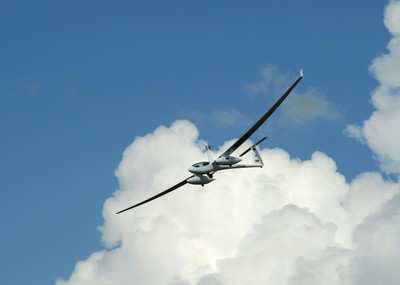"Flying Laboratory" To Help Develop Fuel Cell Technology For
Aerospace Applications
The Antares DLR-H2, which is the world's first piloted aircraft
capable of taking off using only power from fuel cells, did just
that at Hamburg Airport Tuesday. Antares DLR-H2 has been developed
by the German Aerospace Center (Deutsches Zentrum für Luft-
und Raumfahrt; DLR). The Antares flies with zero CO2 emissions and
has a much lower noise footprint than other, comparable, motor
gliders. The propulsion system for this aircraft was developed at
the DLR Institute for Technical Thermodynamics (Institut für
Technische Thermodynamik – Stuttgart) in collaboration with
its project partners – Lange Aviation, BASF Fuel Cells and
Serenergy (Denmark). This motor glider achieves new quality
standards in the field of high-efficiency, zero-emission energy
conversion and clearly demonstrates the progress that has been made
in fuel cell technology.

Photo Credit: DLR
The centerpiece and greatest innovation on the Antares DLR-H2 is
that it is powered directly by means of an ultra-efficient fuel
cell. "We have improved the performance capabilities and efficiency
of the fuel cell to such an extent that a piloted aircraft is now
able to take off using it," stated Prof. Dr-Ing Johann-Dietrich
Wörner, Chairman of the Executive Board at DLR. "This enables
us to demonstrate the true potential of this technology, also and
perhaps specifically for applications in the aerospace sector.
Coupled with our expertise in fuel cell technology, DLR's many
years of extensive experience in gaining official approval for
aerospace systems are what made the Antares DLR-H2 a feasible
proposition."

Photo Credit: DLR
The Antares DLR-H2 is based on the Antares 20E motor glider with
a wingspan of about 60 feet, constructed by Lange Aviation, a
company based in the Rhineland-Palatinate region of Germany. With
its fuel cell propulsion system, Antares has a cruising range of
466 miles, or about 5 hours flying time. In order to accommodate
the fuel cell and the hydrogen supply on board the aircraft, two
additional external load carriers were slung under the specially
reinforced wings. Due to the extra 220 pounds of payload that each
of these removable and flexibly interchangeable containers is able
to carry, the aeroelastic properties of the wings had to be
reconfigured to prevent any adverse impact on the flight stability
of the aircraft. Optimization work at the DLR Institute for
Aeroelasticity (Institut für Aeroelastik –
Göttingen) now provides the Antares DLR-H2 with an assured
capability to fly at speeds of up to 186 miles per hour without any
wing flutter. The current propulsion system permits maximum flying
speeds of approximately 105 miles per hour.

Photo Credit: DLR
The system uses hydrogen as its fuel, and this is
converted into electrical energy in a direct, electro chemical
reaction with oxygen in the ambient air, without any combustion
occurring. During this zero-particulate reaction, the only
by-product is water. If the hydrogen fuel is produced using
renewable energy sources, then the motor glider genuinely flies
without any CO2 emissions whatsoever. The fuel cell is slung under
the left wing and the hydrogen tank under the right wing. The fuel
cell system used to power the Antares delivers up to 25 kilowatts
of electrical power. When flying in a straight line, the aircraft
only requires about ten kilowatts of power. In this situation, the
fuel cell is operating at an efficiency level of approximately 52
percent.
The total efficiency of the drive system from tank to
powertrain, including the propeller, is in the region of 44
percent, making it about twice as efficient as conventional
propulsion technologies based on combustion processes.
"The top priority in this project is of course the safety and
reliability of the fuel cell propulsion system," stated Antares
Project Manager Dr-Ing. Josef Kallo from the DLR Institute for
Technical Thermodynamics. However, having the correct architecture
for the entire system is just as important for full implementation
of this project: "This includes having an absolutely reliable fuel
cell, in conjunction with propulsion system of the aircraft and,
last but not least, a fully mature configuration for the
aerodynamics and aeroelasticity of the motor glider."
 ANN's Daily Aero-Term (04.20.24): Light Gun
ANN's Daily Aero-Term (04.20.24): Light Gun Aero-News: Quote of the Day (04.20.24)
Aero-News: Quote of the Day (04.20.24) ANN's Daily Aero-Linx (04.21.24)
ANN's Daily Aero-Linx (04.21.24) Aero-News: Quote of the Day (04.21.24)
Aero-News: Quote of the Day (04.21.24) ANN's Daily Aero-Term (04.21.24): Aircraft Conflict
ANN's Daily Aero-Term (04.21.24): Aircraft Conflict





